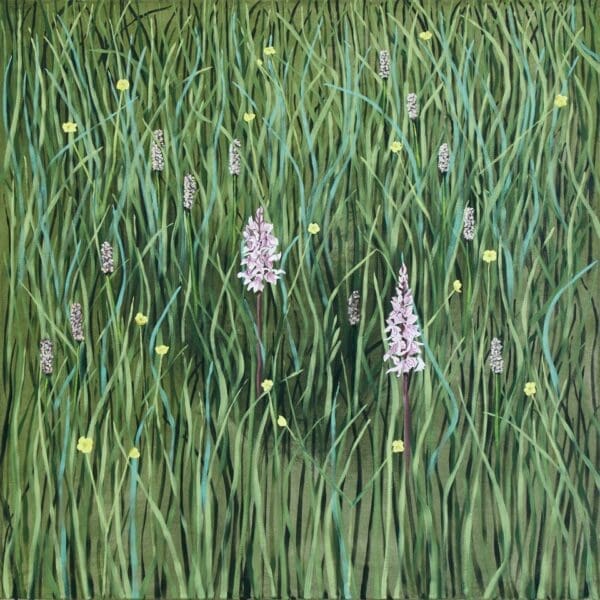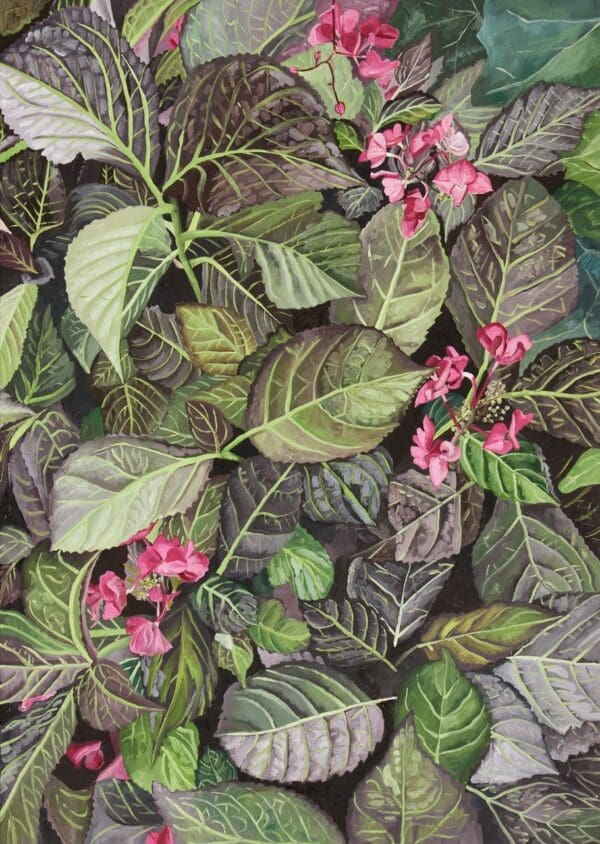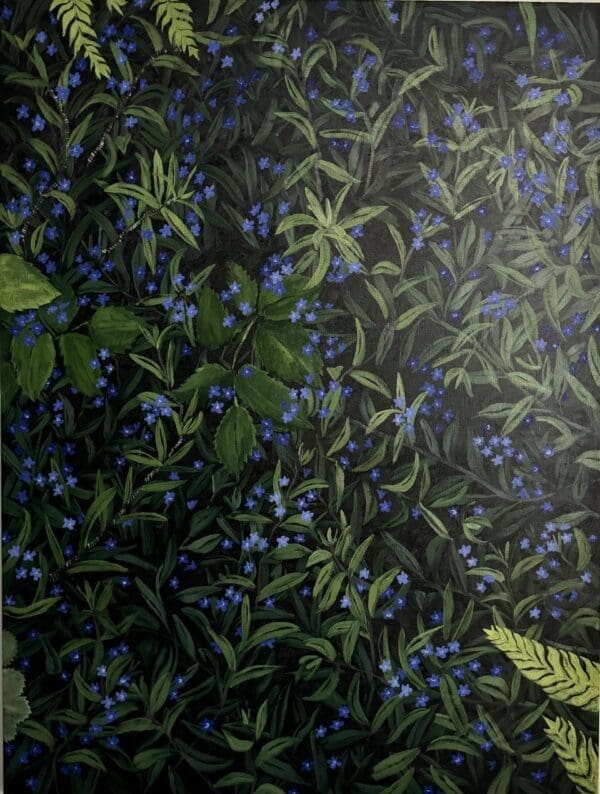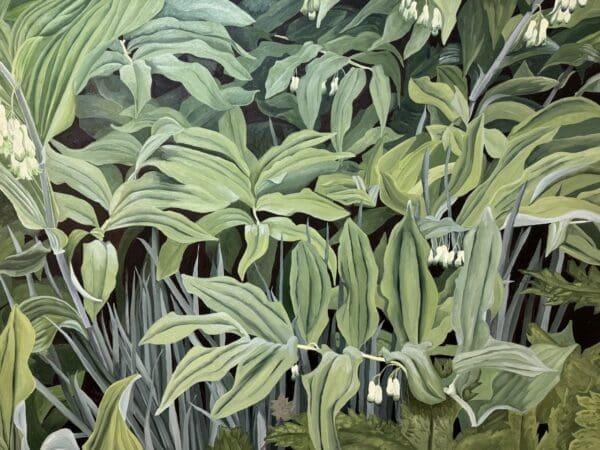
Ever since there has been art, nature has probably been artists’ biggest inspiration. Henry Matisse once said that to express themselves on a canvas, an artist must ‘possess nature’ and able to ‘identify with her rhythm’. By connecting deeply with the natural world through meticulous observation, an artist must devote energy to truly knowing nature before being able to interpret it in their unique style.
This total immersion in the rhythms and essence of the natural environment, I so admired in the sensuous paintings of plants by Endellion Lycett Green in her latest body of work, represented at her first solo exhibition in the Tithe Barn at Thyme in the Cotswolds. Lycett Green’s paintings are an ecological celebration of botanical art. Her impressive, characteristically large-scale paintings, lean towards subtle abstraction, so prized for their form and colour.
How artists interpret plants and landscapes never fails to intrigue. Looking through the eyes of an artist provides a lesson to us all, to admire our plants and gardens for their natural beauty rather than as a protracted list of must-do jobs. “As an artist, I chose to focus on plants” she explains “So I can hide behind the foliage”, laughs Lycett Green. “They have a power. They’re inanimate, yet alive,” she says. Her love of gardens and plants was inspired by her enigmatic mother, the author, journalist and conservation campaigner Candida Lycett Green. “My childhood was spent outside”, she explains, as she describes running through the cow parsley and field maples as a child.
From her paintings, one can gauge Lycett Green’s innate knowledge of and respect for flora and fauna, which by means of her beautiful canvasses manage to cultivate a sense of place and deep personal connection with the plants she paints. She clearly favours plants with strong textures, seed heads and leaf shapes, such as Solomon Seal, eryngium, hosta and artichokes which are painstakingly painted. “I’ll do a leaf until I have it as I want it and then move on to the next, so it could take quite some time until I have, a leaf”, she explains.
The exhibition, endearingly entitled ‘And I Saw Solomon’s Seal‘ consists of a series of beautiful oil paintings inspired by the water meadows at Thyme in the Cotswolds. The meadows are the result of a passionate, twenty-year conservation project run by Caryn Hibbert, the founder and creative director of Thyme. Thyme’s beautiful meadows stretch an impressive 50 acres over the Southrop estate – bursting with buttercups, campion, clover, knapweed and wild orchids. Lycett Green spent the summer of 2023 painting the meadows, the representations of which are currently on show in the form of 17 beautiful paintings at the exhibition.
Having conquered the understandable jitters of a solo exhibition, she spent extensive time in the meadows “drinking it all in, making notes, taking photographs and colour charts – the stuff I do to get ready to paint.” Partly due to the sheer scale of her paintings, Lycett Green doesn’t paint en plain air but spends valuable time, carefully studying her subjects. “At the moment I’m really using my imagination in the painting so you have to reference the plants. I know the colour references very well, as I am familiar with the plants but it’s the structures that are important and I study those carefully from photographs as such an eryngium or artichoke leaf. I admire the structure of the orchids in the grass, how they come up. How present they are within the mess of grass,” she explains
The complex, layered compositions by Endellion are abstract in their focus and have a strong reminiscence of the works of Henri Rousseau and Gustav Klimt. Although unaware of her exacting style, Endellion’s works are truly authentic as she “takes each painting as it comes” and doesn’t purposely think of style. Having said that, she is a great admirer of the likes of Egon Schiele, Gustav Klimt, Edgar Degas, Henry Moore, Dame Laura Knight, Mark Rothko and Milton Avery. “You have to be wary of looking at these people too much, the power of influence is so strong. I like to look at artists that are unrelated to me in terms of style, to understand the structure of their paintings. You look at their work to kindle those fires of inspiration but you have to be careful as you can purposely forge a style, I think. I don’t paint like that, I’m more of a realist,” she says.





Though punctuated throughout by striking colours, Lycett Green’s bluey-green tones dominate her work. “Green is my go to colour” she said. “Browny, misty, bluey, glaucous green. I love all greens. I started with somewhat muddy greens, but they’re lighter and brighter, blue greens now.” She explains that she spends more time mixing the colours than applying them. “I need to get the colours just right. The greens have viridian and dulled-down pewter for a base,” explains the artist. Taught to handle oils by the acclaimed artist, teacher and former Head of Art at Marlborough College, Robin Child (1971-92), she has great respect and reverence for oil painting. “You are always learning with oil paints. They’re such a learning curve but you know you have to have respect for the medium but try not too scared of it because it is quite a task master,” she explained.
Although she describes herself as a “lazy gardener” who “prefers to just stare at things rather than getting deep and dirty”, it’s clear Lycett Green is a knowledgeable gardener. When asked to describe her own garden, a myriad of plants names roll easily off her tongue as she lists a complex horticulture palette of persicaria, eupatorium, solomon seal, crocosmia, japanese anemones, day lilies, forsythia, lavender, dicentra, euphorbia, daphne, lilies and tree peonies that make up her herbaceous borders. She despairs at the wood avens and ground elder that have crept in, muddling the curated melee of russian snowdrops, bluebells, muscari, tellima grandiflora, dryopteris ferns and hosta Halcyon that make up her blue border.
“The garden has a wildness to it that I really like. I consciously cultivate the wild side of my garden”. A style which has been influenced by her close (family) friendship with the design duo, Juliana and Isabel Bannerman. “I know the Bannerman’s from my teens. My mother fell in love with them when we were near Calne. I fell in love with them too. They influenced my garden, even though my plant journeys aren’t like theirs. My pinks for example, which they have lined up in huge swathes, in my garden are but small and short-lived. I think that some plants like you and some plants don’t,” she says thoughtfully.
The intricate play between plants is something Lycett Green truly admires in garden design. She explains how she admires how they manage to weave plants together so seamlessly. She likes the work of Michael Balston and unknown that it was his work, in 2012 so struck by its beauty, she painted Piet Oudolf’s RHS Wisley Borders in 2012. The resulting, substantial 10 by 8ft painting is an intricate composition of Sedum matrona and with globe thistles dancing across the canvas. “It’s just the way that he weaves those thistles in with the sedums that I found so intriguing. The structure of the thistle, with the watery texture of the succulents I found fascinating. I am now challenging myself to paint one of his [Piet Oudolf] vistas for the incredibly beautiful muted colours”, she says.
What perhaps may be everyday plants for many gardeners, seeing Lycett Greens admiration and interpretation of their structure and texture, pushing boundaries and experimenting with her bold colour combinations, transforms them into something extraordinary. Though an admirer of many artists and styles, she stays true to herself and finds joy in her art which is clearly visible in her paintings. Lycett Green’s art offers us all a valuable lesson to really take the time, to admire plants for their individual beauty and as part of the intricate composition that is, a garden. “I have to say that I have learned to just enjoy the garden and not look at it as a job. I have benches everywhere which allows you to sit and enjoy it. You need benches. Too many people don’t sit in their gardens, which is such a shame.”
The ‘And I Saw Solomon’s Seal’ exhibition by Endellion Lycett Green, organised in collaboration with the Laura Lopes Gallery, runs until the 4th of September 2024 in the Tithe Barn at Thyme.

